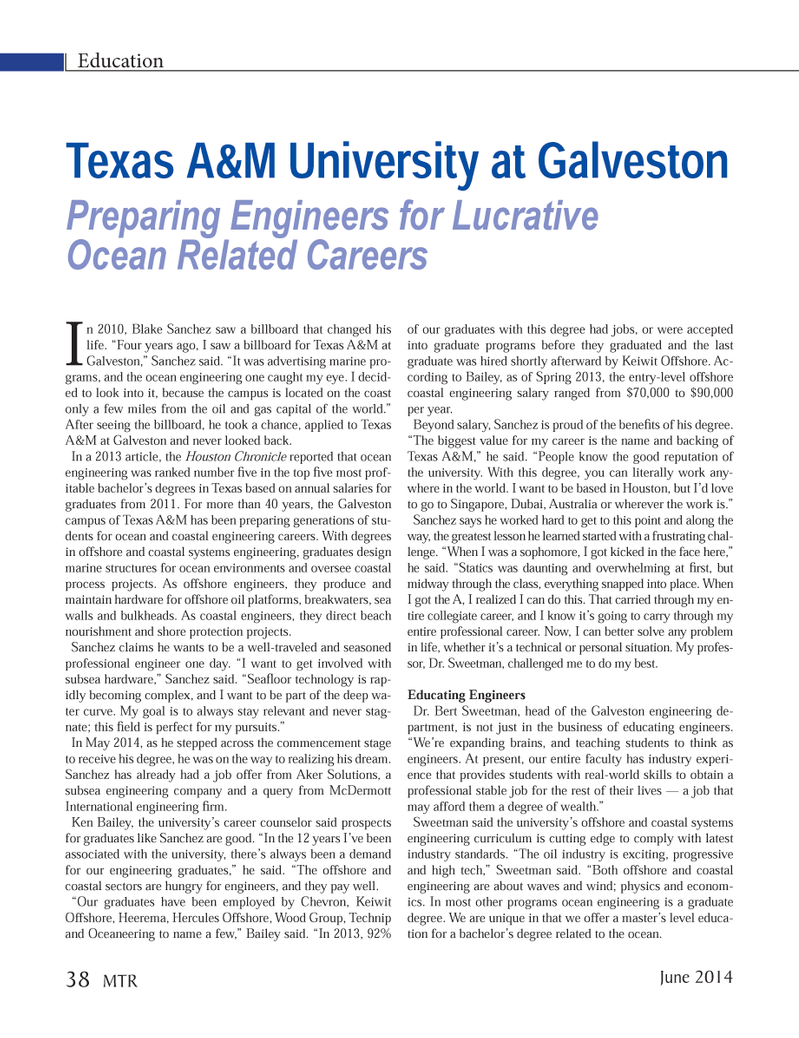
Page 38: of Marine Technology Magazine (June 2014)
Hydrographic Survey
Read this page in Pdf, Flash or Html5 edition of June 2014 Marine Technology Magazine
Education
I n 2010, Blake Sanchez saw a billboard that changed his life. “Four years ago, I saw a billboard for Texas A&M at
Galveston,” Sanchez said. “It was advertising marine pro- grams, and the ocean engineering one caught my eye. I decid- ed to look into it, because the campus is located on the coast only a few miles from the oil and gas capital of the world.”
After seeing the billboard, he took a chance, applied to Texas
A&M at Galveston and never looked back.
In a 2013 article, the Houston Chronicle reported that ocean engineering was ranked number fi ve in the top fi ve most prof- itable bachelor’s degrees in Texas based on annual salaries for graduates from 2011. For more than 40 years, the Galveston campus of Texas A&M has been preparing generations of stu- dents for ocean and coastal engineering careers. With degrees in offshore and coastal systems engineering, graduates design marine structures for ocean environments and oversee coastal process projects. As offshore engineers, they produce and maintain hardware for offshore oil platforms, breakwaters, sea walls and bulkheads. As coastal engineers, they direct beach nourishment and shore protection projects.
Sanchez claims he wants to be a well-traveled and seasoned professional engineer one day. “I want to get involved with subsea hardware,” Sanchez said. “Seafl oor technology is rap- idly becoming complex, and I want to be part of the deep wa- ter curve. My goal is to always stay relevant and never stag- nate; this fi eld is perfect for my pursuits.”
In May 2014, as he stepped across the commencement stage to receive his degree, he was on the way to realizing his dream.
Sanchez has already had a job offer from Aker Solutions, a subsea engineering company and a query from McDermott
International engineering fi rm.
Ken Bailey, the university’s career counselor said prospects for graduates like Sanchez are good. “In the 12 years I’ve been associated with the university, there’s always been a demand for our engineering graduates,” he said. “The offshore and coastal sectors are hungry for engineers, and they pay well. “Our graduates have been employed by Chevron, Keiwit
Offshore, Heerema, Hercules Offshore, Wood Group, Technip and Oceaneering to name a few,” Bailey said. “In 2013, 92% of our graduates with this degree had jobs, or were accepted into graduate programs before they graduated and the last graduate was hired shortly afterward by Keiwit Offshore. Ac- cording to Bailey, as of Spring 2013, the entry-level offshore coastal engineering salary ranged from $70,000 to $90,000 per year.
Beyond salary, Sanchez is proud of the benefi ts of his degree. “The biggest value for my career is the name and backing of
Texas A&M,” he said. “People know the good reputation of the university. With this degree, you can literally work any- where in the world. I want to be based in Houston, but I’d love to go to Singapore, Dubai, Australia or wherever the work is.”
Sanchez says he worked hard to get to this point and along the way, the greatest lesson he learned started with a frustrating chal- lenge. “When I was a sophomore, I got kicked in the face here,” he said. “Statics was daunting and overwhelming at fi rst, but midway through the class, everything snapped into place. When
I got the A, I realized I can do this. That carried through my en- tire collegiate career, and I know it’s going to carry through my entire professional career. Now, I can better solve any problem in life, whether it’s a technical or personal situation. My profes- sor, Dr. Sweetman, challenged me to do my best.
Educating Engineers
Dr. Bert Sweetman, head of the Galveston engineering de- partment, is not just in the business of educating engineers. “We’re expanding brains, and teaching students to think as engineers. At present, our entire faculty has industry experi- ence that provides students with real-world skills to obtain a professional stable job for the rest of their lives — a job that may afford them a degree of wealth.”
Sweetman said the university’s offshore and coastal systems engineering curriculum is cutting edge to comply with latest industry standards. “The oil industry is exciting, progressive and high tech,” Sweetman said. “Both offshore and coastal engineering are about waves and wind; physics and econom- ics. In most other programs ocean engineering is a graduate degree. We are unique in that we offer a master’s level educa- tion for a bachelor’s degree related to the ocean.
Texas A&M University at Galveston
Preparing Engineers for Lucrative
Ocean Related Careers
June 2014 38 MTR
MTR #5 (34-49).indd 38 6/9/2014 10:37:51 AM

 37
37

 39
39
